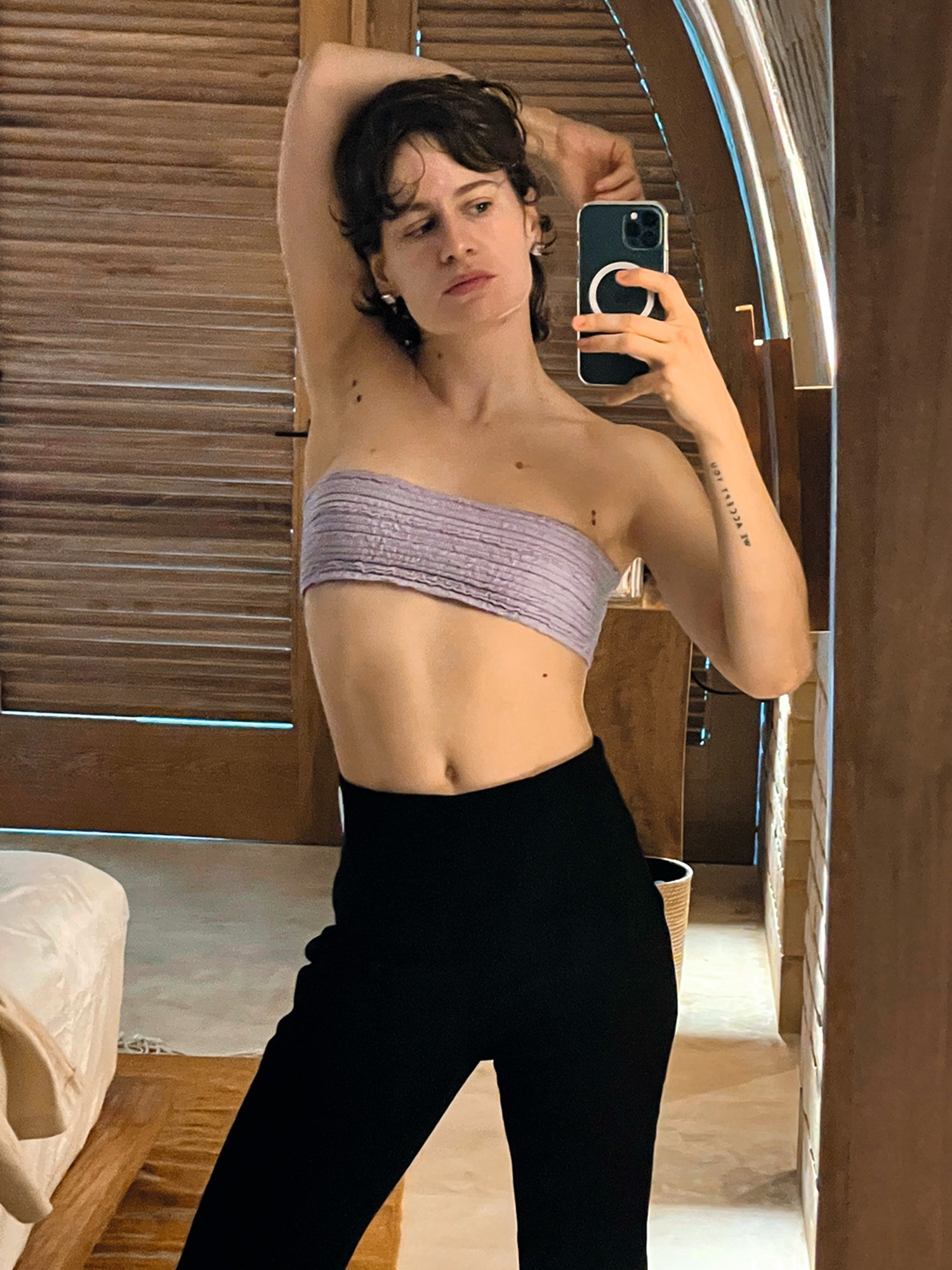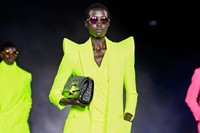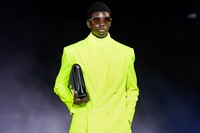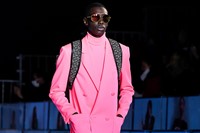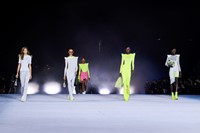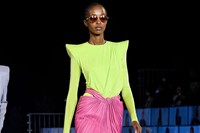This article is taken from the Spring/Summer 2021 issue of AnOther Magazine. To celebrate our 20th anniversary, we are making the issue free and available digitally for a limited time only to all our readers wherever you are in the world. Sign up here.
The synergy between Olivier Rousteing – creative director of Balmain – and the musician Héloïse Letissier, better known as Christine and the Queens, is unexpected but certainly evident. Both were born in France in the latter half of the 1980s – Rousteing in Bordeaux in 1985, Letissier in Nantes in 1988 – each growing up in suburban surroundings and vicariously experiencing the era’s outré fashions and extreme, emotional music. And, in turn, each has revisited those through their work: Letissier’s poetic, electronic output – labelled by the artist herself as freakpop – draws on the syncopated rhythms and melodies of the 1980s, with lyrics sometimes reminiscent of the decade’s larger-than-life ballads. Rousteing likes embroidery, strident colour, strong shoulders – all present at his Spring/Summer 2021 show, where Letissier was in the audience for the first time.
Letissier originally rechristened herself Christine and the Queens during a visit to London in 2010, going on to pursue a career in music after her intended path of theatre faltered. The name came from a troupe of drag queens she bonded with on that trip, although she has always been a solo artist. Christine became her alter ego, a kind of personal ‘queer’ drag that allowed her to be bolder and more extreme. She shortened it to Chris in 2018 for her second album, which bears the same name (her first, Chaleur humaine, was released in 2014) and marked her investigation of her own pansexuality and gender perception, if not identity.
Identity is something Rousteing continually explores too, both of Balmain, the 76-year-old French couture maison whose creative directorship he assumed in 2011, and his own. He was the first person of colour to lead a French house and remains one of remarkably few in the industry, innately aware of the importance that places on his role as a figurehead. He is often disarmingly honest: he has documented his time at Balmain via social media, helping to lead the brand – and, perhaps, fashion as a whole – into the digital age. He’s also sometimes vulnerable, as demonstrated in the 2019 documentary Wonder Boy, which recounted how Rousteing was given up for adoption as a newborn by his 15-year-old biological mother. It has a rawness that’s rare in fashion, especially given the glossy box into which Rousteing is so readily pigeonholed.
Letissier and Rousteing’s mutual admiration had long been simmering before the two first worked together last spring, devising outfits of attenuated, kicked-out flares and billowing bloused volume for her performance as part of Global Citizen’s Global Goal concert, a digital event staged in June. But their admiration also reflects shared goals, ideals and philosophies – they met again during the 2020 Black Lives Matter marches in Paris, “a moment where we were fighting for the same reason”, Rousteing asserts.
Olivier Rousteing: When I love someone, I go full-on. When we met, I became obsessed more than ever. Not only because of your music, but because of the person I met.
Christine and the Queens: It was really poetic as a collaboration. You really entered my universe and I received yours, and it was pretty absorbing. It’s a wonderful way to meet someone, to collaborate. I like when there’s human feedback and you click on a poetic level.
OR: It was poetic – and poetic is not a word you would use for Balmain, because it’s always really fierce. But when you collaborate, it’s not just about creating clothes, it’s about understanding the world of the other person, and making sure that world is represented by the clothes. I learnt a lot. As much as I learnt with Beyoncé, I learnt with you.
CATQ: You made my day. It must be fascinating to collaborate with different performers, because when you work with Beyoncé, you craft 20 outfits or maybe more.
“It’s almost like you helped me perform by putting me in the precise shape I needed ... It’s not about being well dressed, it’s about what I want to convey as an emotion” – Christine and the Queens
OR: It’s different because they dance so much – you need to do a lot. What I love about the performance we did together was that you played with the clothes on your own in a huge space [the vast vaulted hall of the Grand Palais, Paris], and that was isolating but at the same time really welcoming.
CATQ: As an artist, I always think about Bowie. Because he understood the power of the right outfit so well. You helped me perform by putting me in the precise shape I needed. I think sometimes when a collaboration doesn’t work, it’s because [the artist doesn’t] really think about the power of the clothes – they just want to dress well. For me it’s not about being well dressed, it’s about what I want to convey as an emotion, and because you work with such strong performers, you understand that. It didn’t feel like I had to explain shit to you. It flowed quite easily. And that was very relaxing in a complicated year. A crazy year.
Lockdown for me was like a trip down memory lane, because this whole thing started with me on my own, knowing nobody. So it was like being myself ten years ago, in my room, depressed, with just a computer, trying to figure things out. I wanted to do theatre before, I didn’t plan to become a musician. I was learning this language and I figured things out by fiddling around for hours on my own.
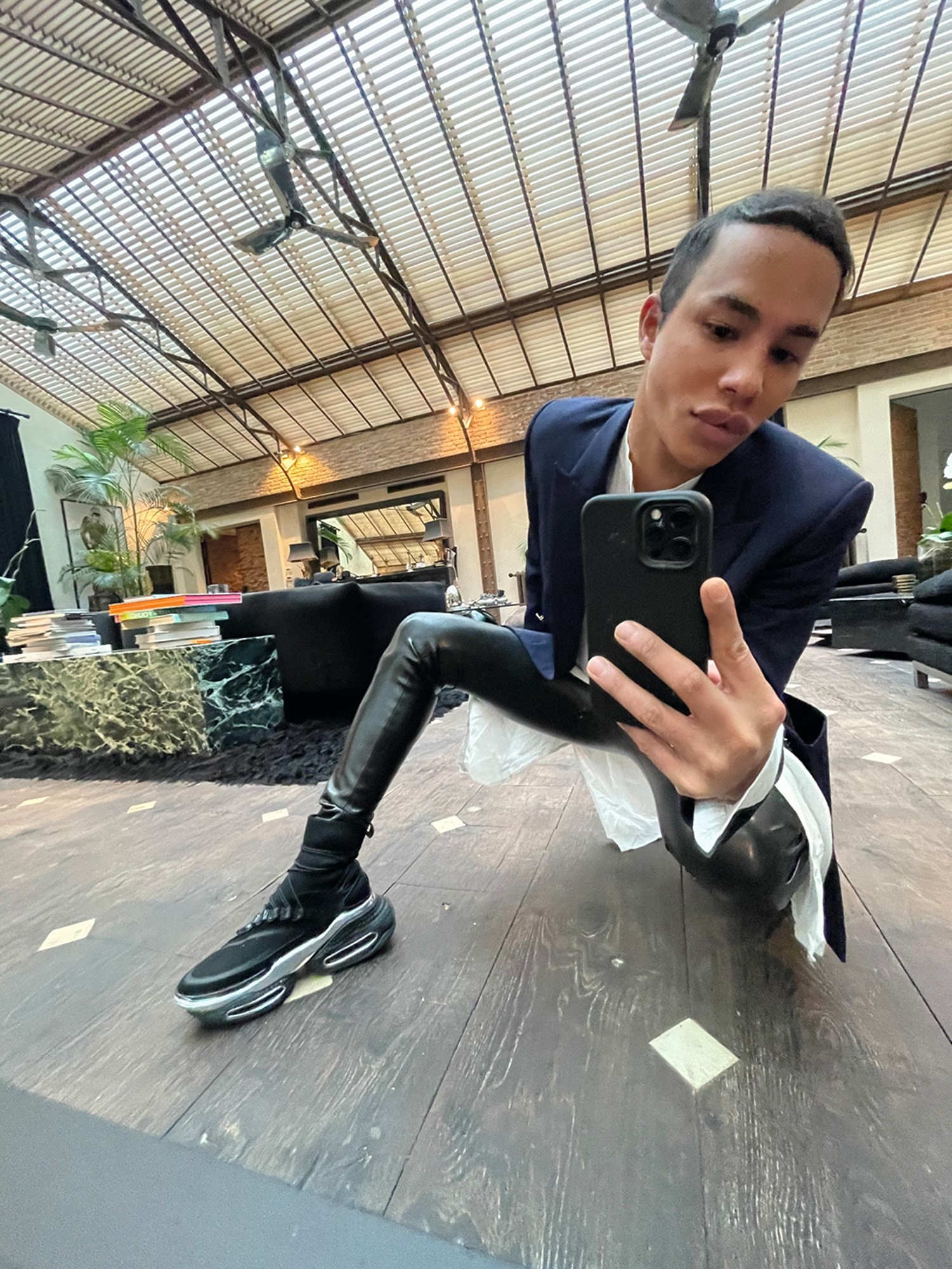
OR: I agree. I think this pandemic has brought us back to who we really are and the struggle of thinking on our own, not having too many people around. You were creating your own music, your own sound, in this empty space with no one around. It was the same for my collection – I was sketching on my own and hoping that [the world] would open again. It was this feeling of coming back to who we were, in a way. And it’s not a bad thing at all.
CATQ: I like to collect sensations as a performer, and I remember the sensations of performing in your clothing. It felt good. I think fashion is about creating a feeling, and the feelings I have wearing your clothing are very, very satisfying.
OR: With my last fashion show, the September one where you can see men and women wearing some of the same clothes, the inspiration came from you. Because I loved this idea of dandyish glamour. The free spirit as well. Knowing you helped me to discover myself more – I always had this dandyish aspect in my collections, but you became the symbol of it.
“With my last fashion show ... the inspiration came from you. Because I loved this idea of dandyish glamour. The free spirit as well. Knowing you helped me to discover myself more – I always had this dandyish aspect in my collections, but you became the symbol of it.” – Olivier Rousteing
CATQ: I remember beginning my career and choosing to wear men’s clothing, like the tuxedo, Le Smoking. It was very naive of me, but I wanted to deflect the male gaze. I thought, “I’m going to suppress the easy information of a female body to trick people into listening and paying attention to the words.” Because I was terrified of being reduced to, “We know how women are.” [I wanted my outfits to] just swallow the male gaze, in the way authors can just disappear.
Choosing a uniform at the beginning was also very strategic, to protect myself from attack. I thought, “I’m just going to be neutral.” Which wasn’t the case because I was actually gender fucking, but it was subconscious. I talk about being a bit non-binary now, but at that time it was way more instinctive and I didn’t have the words for it, I just felt intensely fluid. Every pop performer plays with the theatricality of clothing to create a character. Lady Gaga, for example, was sexy but really freaky sometimes. I adored that, it was clever.
For my second record, Chris, I was showing more skin and I was realising myself, but still in a butch, classically masculine way. It enriched the narrative to the point that people asked me if I was transitioning, which irritated me. Patriarchy is so strong that, when a woman is powerful, she has to be a man. I said, “No, I’m not transitioning. I’m just a butchy woman.” The reactions depressed me – I was having conversations that I thought were done for ever. It shows how we still have to dismantle the patriarchy.
OR: So true. I agree, when you dress a woman in a tailored jacket, people say, “You dress like a man.” No, you don’t dress like a man, you dress like another kind of woman.
I think Balmain as a brand is sometimes misunderstood because people see the glamour of Balmain as this va-va-voom, rich, fabulous woman. For me, a strong woman with full-on embroidery is not an object or a trophy wife. She’s a woman wearing armour. I’m obsessed with those Helmut Newton pictures where women dress like men or men wear high heels. Gender and diversity have always been important to me. When I created this Balmain army, people asked why it’s an army and I said, “Because we need to fight.” I know that might sound bad – to say “fight” – but we need to. You fight with your lyrics, I fight with my clothes.
CATQ: I remember seeing your armies and feeling that power. Even if I didn’t wear the clothes myself, as a woman, I’m empowered by seeing that. So in terms of visibility or representation, as an artist, there is a – I was about to say duty, we’re using very serious words – but a need to show that to other people, to empower. So you might be misunderstood by some people, but you empower many others. I mean that.
OR: It’s a matter of message – if you have something to say, you say it. If you don’t, stay silent, but you’re not going to be relevant. You can see when it’s awkward – for example, it was so funny to see some of the industry talking about Black Lives Matter when there are barely any Black people or [people of] different origin in their casting. With gender it’s the same. You can see when it’s real. This is going to be the future – people want a new world. You can see the difference between the front rows of today and the front rows of yesterday. But I had to fight for many years in fashion for my diversity to be understood.
“I remember seeing your armies and feeling that power. Even if I didn’t wear the clothes myself, as a woman, I’m empowered by seeing that” – Christine and the Queens
CATQ: Was it hard to impose that diversity right away? Because I had suffered misogyny when I worked in theatre before, I entered a record label saying, “I’m not going to be dispossessed of my art, ever. I can’t because it will kill me if it happens again.” It was an obligation I had to myself. Did you start fashion with the same idea?
OR: I didn’t. If I have one regret, it’s that I tried so much to be part of the fashion crowd at the time. When you want to be the ‘cool’ fashion designer from France, you need to learn all the songs by Serge Gainsbourg and Jane Birkin, and be obsessed with Brigitte Bardot. Because Bardot is really the icon of fashion in France. If you look like her, you’re OK. I started Balmain like that. And when I began to say that I wanted to have a different front row, that I love hip-hop, people were like, “This is not chic. This is not a French house. Why use social media?” With all of that, I was crossing the line. I was saying, “I’m not going to be the ‘good’ designer, the ‘right’ one.”
Today, people call me controversial. I’m not, I’m just myself. But the first two years were difficult and I had to stop working with many strong people from fashion who didn’t have the same vision as me.
CATQ: But then you learn from that. It’s about bravery at some point.
This article originally featured in the Spring/Summer 2021 issue of AnOther Magazine which will be on sale from 8 April, 2021. Pre-order a copy here and sign up for free access to the issue here.
